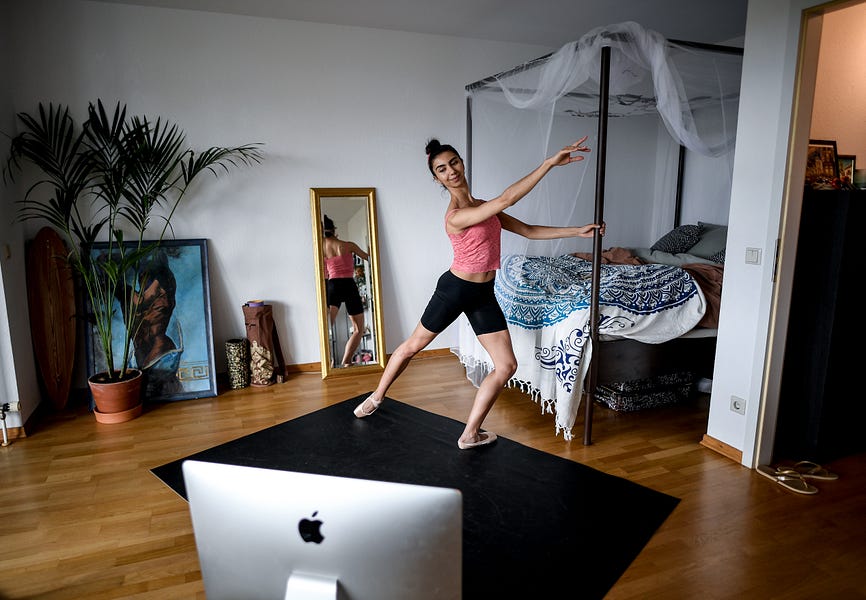After Alabama Ballet cut its season short at the start of the pandemic, company ballet dancer Jimmy Shughart said he expected the shutdown to be temporary. “We were like, ‘Oh, we’ll come back in two weeks.’ And then it turned into April, and then got later and later. And then the season was canceled.” Once his studio’s doors closed last spring, Shughart and his boyfriend took up different methods of cross training to maintain their athleticism while in quarantine as they bounced back and forth between their family homes.
Shughart, who has danced full-time with Alabama Ballet since 2019, is one of thousands of dancers across the country whose careers have been completely upended over the past year. Forced to dance from home, social distance while onstage, and even double mask when back in the studio, ballet dancers have brainstormed creative solutions to keep their industry alive during the pandemic.
Luckily for Shughart, Alabama Ballet kicked off its season in September to begin preparing for the Nutcracker, which the company was able to perform live at 30 percent capacity. The company has also live-streamed several performances since returning in August, and was able to team up with a local brewery to use its outdoor space for another live show.
“We’ve tried our hardest to make it a pretty normal season in terms of the [repertoire] that we’re doing,” Shughart said. “A lot of things did have to get switched around just because of money and expenses that we couldn’t afford because we did lose money due to the pandemic.”
Shughart said that dancers were able to wear clear face masks during performances so the audience could see their smiles. But in-studio training required double masking. “During Nutcracker, just because we have so many people in the studio, we would double mask,” he said, explaining that they were required to wear both a cloth mask and a medical grade mask.
Shughart said he prepared for his company’s COVID-19 training protocol by going on long runs at the beginning of the season. “I think everyone selflessly was willing to have to build up that stamina just to make sure that we could perform and get back on stage,” he said.
Moving forward, Shughart thinks the pandemic will take a huge financial toll on the ballet industry. “I hate to say that I feel like some of the smaller companies aren’t gonna be able to make it through without those ticket sales,” he explained. “Most companies here in America are nonprofit. So if we don’t have people coming out, if we can’t have dancers in studios practicing, you can’t have shows, can’t make money.”
Aspen Santa Fe Ballet is one such example of a nonprofit dance company struggling to stay afloat despite major financial losses. After the pandemic slashed its operating budget from $4.2 million to $1.5 million, Aspen Santa Fe Ballet announced this spring that the company will be permanently shuttering its in-house productions, though it will keep operating its five dance schools virtually.
Company shutdowns are especially worrisome for young dancers. Kathleen Tiernan, a trainee at Ballet Austin, fears that the pandemic will financially stunt the ballet industry for years to come. “I don’t know that I would wanna risk going to one of those small companies that could be very close to shutting down,” said Tiernan, who is still in auditions season. “And I don’t know how they’re surviving because those types of companies were already struggling before the pandemic and already paid their dancers unlivable wages.”
Tiernan said the pandemic has been an incredibly isolating experience for dancers. “We happened to be on our spring break when everything shut down, and then they extended one week,” she said. “Then they extended another week. And then they told us that we wouldn’t be returning for the rest of the season, and a lot of places continued Zoom, like teaching classes or even doing rehearsals. But my particular company, we just kind of dropped off and didn’t really do anything at all, which was really tough because I was just in my apartment. Nothing to do.”
She used her apartment windowsill as a surrogate ballet bar before returning home for the summer, where she was able to use an old gymnastics bar in her basement to train instead.
“The first time that we took class in this new apartment, our neighbors came upstairs and banged on our door and they were like, ‘What are you doing?’ Because we had been jumping and I thought, ‘Oh, no, this is gonna be a horrible year. I can’t even jump without my neighbors being disturbed.’ ”
After months of taking classes online over the summer, Tiernan was finally able to return to the studio at the end of August. “It was very controlled at first, and we would only go in very small groups,” Tiernan said. “At first, I could only go in with my roommate, and then they were able to expand to a group of five. And then, actually, as of today,” Tiernan explained in early March, “We just kind of leveled up one more level, and now we’re in groups of 10.”
She estimates that her studio won’t begin performing in-person until the fall. “We can’t even really do live streams just because there’s too much of a liability in case somebody happened to get sick or exposed,” she said. But she’s hopeful that this year will transform the industry for the better. “The ballet community is very resilient,” she said.
Brainstorming creative ways to keep dancers in the studio during the pandemic has been a key ingredient for industry success. “If you’re not working out as much as you normally do, that can slump your drive,” said dancer and choreographer Andile Ndlovu, who is in his ninth season with Washington Ballet.
Ndlovu’s company welcomed dancers back to the studio in August for its “Create in Place” initiative, which has allowed choreographers to create short films that are available for streaming on Marquee TV. To keep dancers in the studio, the company divided dancers into four isolated pods of 10 dancers each. “We have not done live performances,” Ndlovu said. “At this point, we are really following the mayor and what she says, so you can’t do anything like that.”
Despite the circumstances, Ndlovu is optimistic that droves of people will watch ballet as soon as the pandemic subsides. “I think we will see more people coming back to the theater because even indirectly in the past, people have taken live performances for granted,” Ndlovu said.






Please note that we at The Dispatch hold ourselves, our work, and our commenters to a higher standard than other places on the internet. We welcome comments that foster genuine debate or discussion—including comments critical of us or our work—but responses that include ad hominem attacks on fellow Dispatch members or are intended to stoke fear and anger may be moderated.
You are currently using a limited time guest pass and do not have access to commenting. Consider subscribing to join the conversation.
With your membership, you only have the ability to comment on The Morning Dispatch articles. Consider upgrading to join the conversation everywhere.